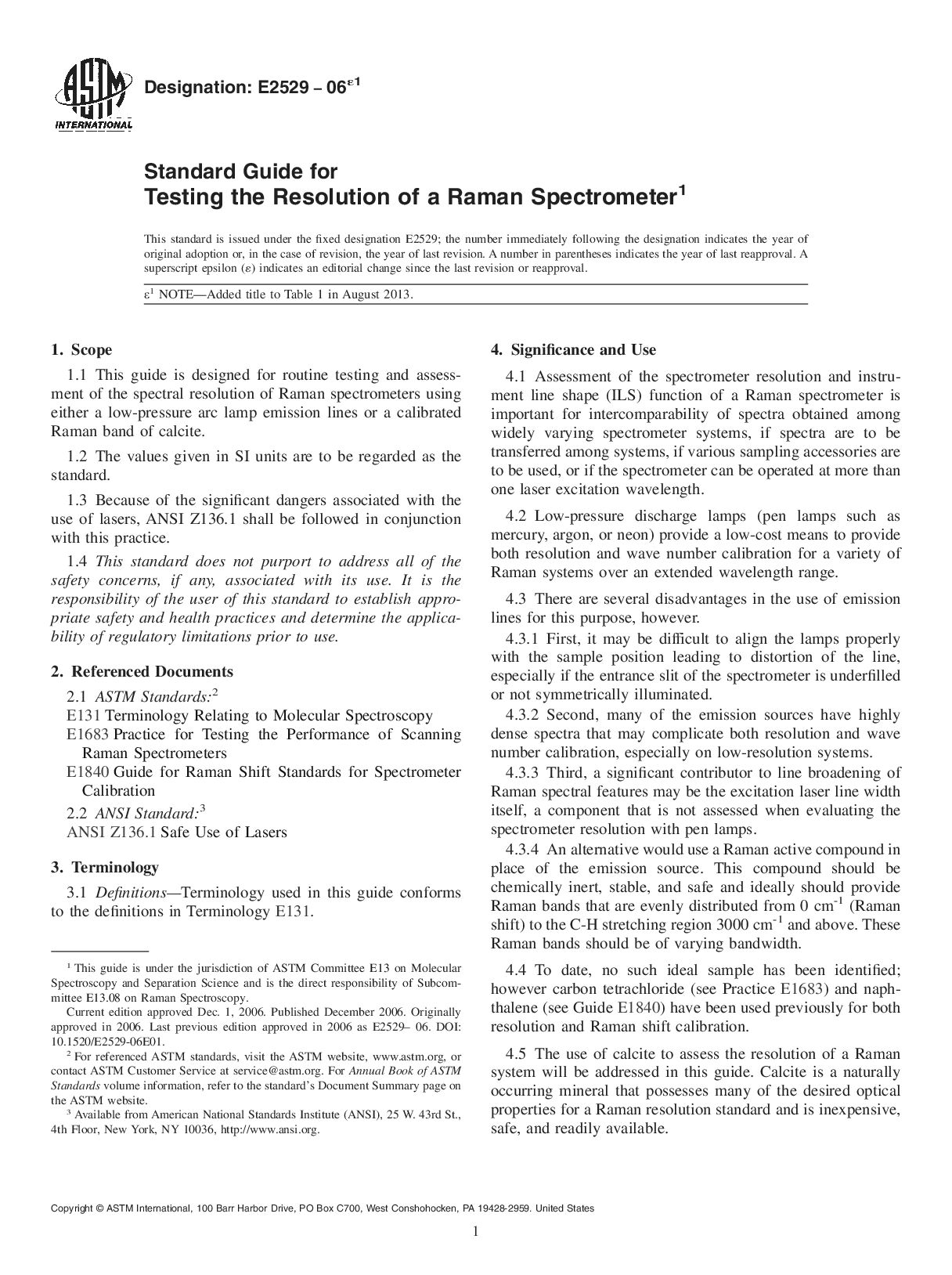ASTM E2529-06e1
測試拉曼光譜儀分辨率的標準指南
Standard Guide for Testing the Resolution of a Raman Spectrometer
- 標準號
- ASTM E2529-06e1
- 發布
- 2006年
- 發布單位
- 美國材料與試驗協會
- 替代標準
- ASTM E2529-06(2014)
- 當前最新
- ASTM E2529-06(2022)
- 引用標準
- ANSI Z136.1 ASTM E131 ASTM E1683 ASTM E1840
- 適用范圍
4.1 Assessment of the spectrometer resolution and instrument line shape (ILS) function of a Raman spectrometer is important for intercomparability of spectra obtained among widely varying spectrometer systems, if spectra are to be transferred among systems, if various sampling accessories are to be used, or if the spectrometer can be operated at more than one laser excitation wavelength.
4.2 Low-pressure discharge lamps (pen lamps such as mercury, argon, or neon) provide a low-cost means to provide both resolution and wave number calibration for a variety of Raman systems over an extended wavelength range.
4.3 There are several disadvantages in the use of emission lines for this purpose, however.
4.3.1 First, it may be difficult to align the lamps properly with the sample position leading to distortion of the line, especially if the entrance slit of the spectrometer is underfilled or not symmetrically illuminated.
4.3.2 Second, many of the emission sources have highly dense spectra that may complicate both resolution and wave number calibration, especially on low-resolution systems.
4.3.3 Third, a significant contributor to line broadening of Raman spectral features may be the excitation laser line width itself, a component that is not assessed when evaluating the spectrometer resolution with pen lamps.
4.3.4 An alternative would use a Raman active compound in place of the emission source. This compound should be chemically inert, stable, and safe and ideally should provide Raman bands that are evenly distributed from 0 cm-1 (Raman shift) to the C-H stretching region 3000 cm -1 and above. These Raman bands should be of varying bandwidth.
4.4 To date, no such ideal sample has been identified; however carbon tetrachloride (see Practice E1683) and naphthalene (see Guide E1840) have been used previously for both resolution and Raman shift calibration.
4.5 The use of calcite to assess the resolution of a Raman system will be addressed in this guide. Calcite is a naturally occurring mineral that possesses many of the desired optical properties for a Raman resolution standard and is inexpensive, safe, and readily available.
4.6 The spectral bandwidth of dispersive Raman spectrometers is determined primarily by the focal length of the spectrometer, the dispersion of the grating, and the slit width. Field portable systems typically operate with fixed slits and gratings and thus operate with a fixed spectral bandwidth, while in many laboratory systems the slit widths and gratings are variable. The spectral bandwidth of Fourier-Transform (FT)-Raman systems is continuously variable by altering the optical path difference of the interferometer and furthermore is capable of obtaining much lower spectral bandwidth than most practical dispersive systems. Therefore, data obtained of a narrow Raman band on a FT-Raman system can be used to determine the resolution of a dispersive Raman ......
ASTM E2529-06e1相似標準
推薦
便攜式拉曼光譜儀國內外技術PK
光譜儀 微型光譜儀是便攜拉曼的“心臟”,光譜儀的性能直接影響拉曼的光譜分辨率,靈敏度和光譜檢測范圍。目前國內拉曼采用的光譜儀相較進口產品存在較大差距。例如,國內拉曼的分辨率一般在10cm-1左右,而國外拉曼的分辨率一般在5cm-1左右,其中美國B&WTek多種型號的光譜儀能達到3.5cm-1(ASTM標準方法測量)。另外,國外光譜儀在CCD封裝,噪聲控制等方面表現更佳。...
【華恒儀表冠名】20年來首次修訂 新版《激光拉曼光譜分析方法通則》12月1日實施
新標準規定了用色散型顯微激光拉曼光譜儀檢測物質拉曼光譜的方法原理、校準用器具及材料、儀器環境、儀器、試樣的制備、分析測試,以及安全、維護注意事項,適用于色散法激光拉曼光譜的常規分析。?本標準適用于色散法激光拉曼光譜的常規分析。...
SENTERRA II緊湊型拉曼顯微鏡
、ASTM E1840和E2529-06標準的全自動化儀器測試 完全符合GMP/cGMP、GLP和CFRp11要求 開放架構版本,具備更高橫向分辨率,適用于分析較大的樣本(譬如藝術品) 使用的技術受以下專利保護: US 6141095; US 7102746...
ASTM E2529-06e1 中可能用到的儀器設備
Copyright ?2007-2022 ANTPEDIA, All Rights Reserved
京ICP備07018254號 京公網安備1101085018 電信與信息服務業務經營許可證:京ICP證110310號
